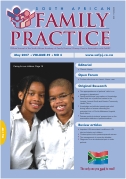The appropriateness of patients’ visits to an emergency department. [Die toepaslikheid van pasiënt besoeke aan ‘n noodgevalle eenheid]
Keywords:
toepaslike besoeke, noodgevalle,
Abstract
Aim: The appropriateness of patient visits to an emergency unit was investigated in this study. Method: This descriptive study included 2968 patient cards from the National District Hospital, Bloemfontein emergency unit during 2003. Patient information was evaluated according to predetermined criteria to determine whether a visit was appropriate or not. Results: The patient’s ages varied between 0 to 97 years (median 29 year) and 50.8% was female. Informal residencies presented 26.4% of patient’s neighbourhoods. The most common chronic condition was hypertension (7.9%). Only 8.4% of patients already used medication for their presenting condition. Most (72.4%) patients presented after hours and 36.6% presented during weekends. The total number of injuries was 22.9% and 75.6% were examined for medical or surgical problems. The criterion with the most visits was the trauma category (21.8%). The criterion with the least patients (0.3%) was the criterion for significant bleeding. According to the results more than a third (35.4% ; 95% CI 33.7% ; 37.2%) of the patient visits can be seen as inappropriate. Conclusion: The emergency unit is used inappropriately.
Published
2007-05-06
Issue
Section
Original Research
By submitting manuscripts to SAFP, authors of original articles are assigning copyright to the South African Academy of Family Physicians. Copyright of review articles are assigned to the Publisher, Medpharm Publications (Pty) Ltd, unless otherwise specified. Authors may use their own work after publication without written permission, provided they acknowledge the original source. Individuals and academic institutions may freely copy and distribute articles published in SAFP for educational and research purposes without obtaining permission.

